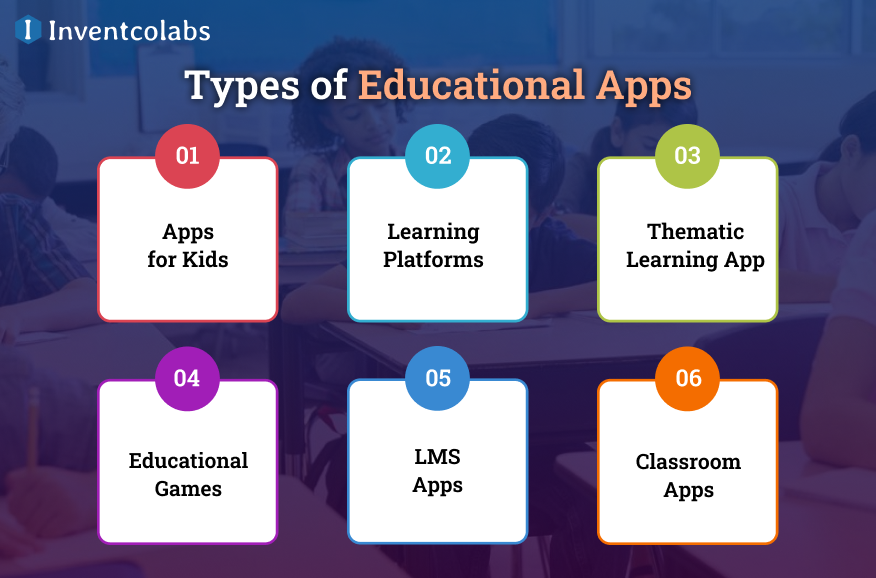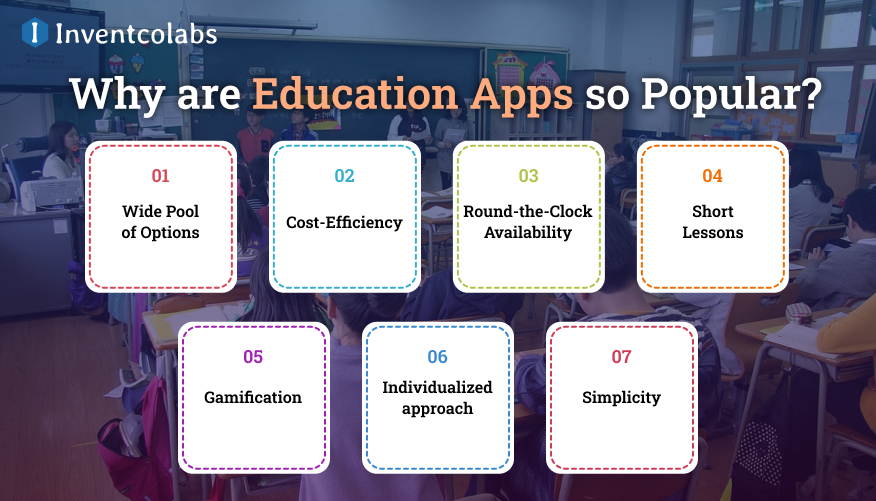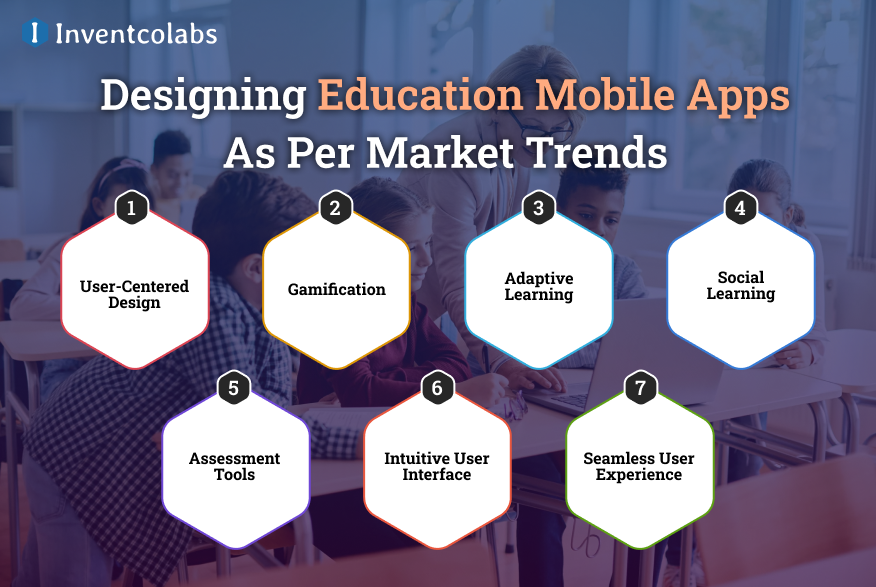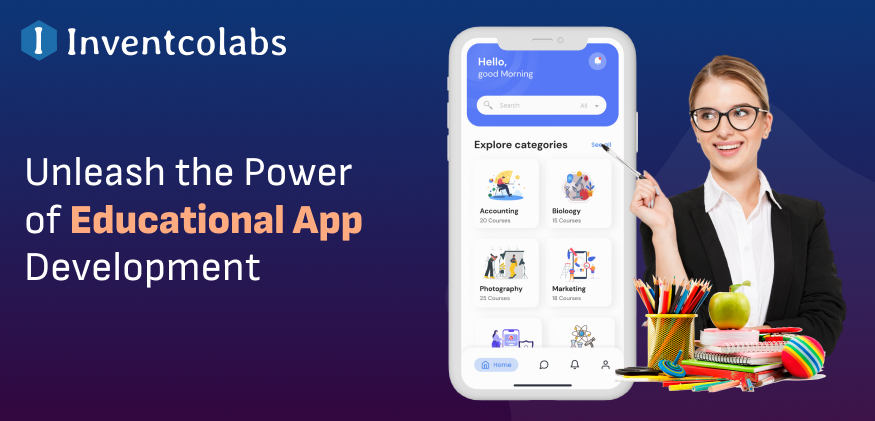The time to digitize education has arrived. In the last few decades, E-learning solutions and edtech apps have gradually overtaken the traditional method of in-person instruction.
The past few years have seen the setting of a benchmark in the field of app development for education and positioned it for growth of $1.72 trillion in 2022 between 2022 and 2026.
The current high in digital education was caused by social isolation, curfews, and a shortage of entertainment options. Specifically, the pandemic forced schools and businesses to embrace mobile learning tools offered by private content companies. Innovative teaching techniques and continuous accessibility are other advantages of a mobile-based education system in transitioning towards mobile-based solutions. Mobile-based learning allows you to deliver practical training in the present.
If you are also looking to develop your online education app and are searching for easy steps, this blog is for you. This blog will elaborate on an educational mobile app development procedure to make it easier for you to get going. Let’s get into the specifics:
Types of Educational Apps

The first step when creating an educational application is to select the kind of app. It doesn’t mean you must restrict yourself to one type only. Mixing and matching features and adding additional modules to develop unique Learning App Development Solutions is possible. However, establishing the principal direction plays a crucial impact in defining your market, budget for development, and marketing strategy.
>Apps for Kids
In 2023, it is evident that kids will spend much of their time using smartphones and tablets. For instance, Statista claims that around 15 percent of US children are on their devices for over four hours per day. Creating an app that educates children about the importance of technology can make this time productive for kids. Mobile phones can help children learn to speak, read, and write. One good example is Encantos. The app is packed with stories, videos, and minigames to help children understand their world.
>Learning Platforms
A learning platform is a massive assortment of classes, courses, and webinars that customers can access for free or at a set price. If you’re planning on developing this kind of service, be sure it has a sleek design and easy navigation for tutors and students.
The most prominent learning platforms with millions of users include Coursera, Udemy, and Skillshare.
>Thematic Learning App
If you’re an expert in a specific sector and want to concentrate on a particular area, the best choice would be a thematic learning application. It will focus on an area of preference. For instance, you could launch a language program or an app that can aid people in learning to play the guitar. This can help determine your market and develop more specific marketing campaigns.
Thematic apps for learning to pay attention include Duolingo, Mathway, and Simply Piano.
>Educational Games
We’ve already discussed the gamification features in apps for learning. However, when they are instructional games, the components constitute the game’s main feature. Most of these will be intended for children since they are avid gamers, but they will need significant studies into the psychology of children. There is also the possibility of an adult-oriented game. Everybody has a kid in us.
MentalUP, Curious World, and Kahoot are great examples of your market analysis.
>LMS Apps
Learn management software (LMS) is generally utilized by businesses that want to ensure a consistent employee education process. Using software that can do this, companies can develop a collection of education materials that employees can access anytime. A great CMS must include the following:
- An online mode.
- Progress-tracking tools for scheduling.
- A high degree of personalization.
To mention some LMS options, we can include TalentLMS, Adobe Learning Manager, Canvas, and Edmodo.
>Classroom Apps
In addition to LMS, teachers have a different option: classroom apps. They typically don’t offer the ability to learn but serve as a management system. Teachers usually utilize them with students and parents to monitor the development of their learning.
Explore More: How To Build An Education App with Features in 2024
Why are Education Apps so Popular?

In addition to external factors that drive people towards the internet, mobile apps for education have numerous reasons for becoming loved by the masses. Here are the most pertinent ones:
>Wide Pool of Options
Because online educational programs are widely available and aren’t restricted by any geographic borders, individuals have many more options. They do not have to look at local colleges, schools, or other education opportunities. Today, students can access educational materials and services from virtually every location they’d like. Many people combine online learning with traditional education thanks to educational apps. However, there is a lot of competition, so it is essential to be aware of it when determining your niche.
>Cost-Efficiency
There are no-cost mobile educational apps. For instance, some applications for learning languages, such as Duolingo, permit you to master new languages without paying even a cent. Even if the application is paid for or comes with a subscription model, however, it is less expensive than, say, hiring dedicated developer. A mobile application can be affordable for all without significant investment, which can be affordable for all.
>Round-the-Clock Availability
If you have an iPhone, you can get any information you need anytime you need. Traditional colleges, schools, and universities cannot be accessible now. There are specific times during which students can study and speak to their instructor. You can take your time studying at any time through mobile-based educational applications.
>Short Lessons
In addition to being accessible at all hours of the day, learning materials found in educational apps are generally delivered in shorter classes. This makes it much easier to make the time to study in our hectic and crowded world. If the lessons aren’t too long, students are more likely to attend, which will increase their efficiency and effectiveness.
>Gamification
Another benefit of mobile apps is the way they instruct. Contrary to traditional educational institutions and even online courses, mobile apps can be engaging for students. Whether students are teens, children, or adults, everyone likes having fun. An excellent education app can provide interesting tasks and rewards to help you learn.
>Individualized approach
Many educational applications let you create a profile using your name and photo, where you can store your favorite lessons and monitor your development. You can also pick what you’d like to study in any form at any time. This degree of individualization makes mobile learning even more appealing to students.
>Simplicity
Lastly, educational apps have fundamental UX/UI designs. They can adapt to the mobile screen we are accustomed to, making these apps more attractive to the users. These arguments seem abstract, but they can be proved through figures. Here are the most significant data on educational apps to demonstrate how the use of mobile technology in education is growing:
- In the first quarter of 2020, the number of global edu apps downloaded reached 936 million. (Statista)
- The total investment in edtech totaled $18.66 billion in 2019, with the US producing 42.9 percent of it. (Insider)
- The market for mobile learning could reach $80.1 billion in 2018, making it the fastest-growing e-learning industry. (Globe News Wire)
- E-learning can increase the retention rate by 25-60 percent. (SH!FT)
- The most downloaded educational apps of 2021 were Google Classroom, Toca Life World, and Duolingo. (Statista)
We now know that developing educational apps is applicable; we’ll look at the different e-learning applications you could create.
How To Create An Education App: Step-by-Step Process

The development of an educational app is complex and involves various steps to develop an educational application that is efficient, engaging, and user-friendly. Here’s a brief outline of the main aspects involved in application development:
>Ideation
This phase involves brainstorming ideas for developing educational apps. Researching your audience, determining their requirements and issues, and brainstorming ways to meet those needs is essential.
>Research
Once you’ve developed a concept for your app, it’s time to investigate the market and competitors. This will help you comprehend current trends in educational apps, identify market gaps, and refine your concept.
>Design
The design stage is essential to creating a user-friendly and engaging educational application. It involves creating your User Interface (UI), User Experience (UX), and the visual components that make up your application. This involves wireframing, prototyping, and drafting the style guide.
>Development
When the design is finished, it’s time to develop an educational app. The process typically involves programming and coding, as well as features like social learning, gamification, and assessment instruments. It employs a team of developers or contracts development as the whole work is possible.
>Testing
The development of a mobile app for education involves the testing phase. After the app is developed, it should be comprehensively tested to ensure it’s bug-free and operates as intended. This phase includes testing beta versions of users’ testing and tests to ensure quality.
>Deployment
Once your educational app has been checked and approved, it’s time to release it on an app store or marketplace. This phase involves creating an account on the store, enhancing your app to be search engine friendly, and establishing an advertising strategy to market your app. The development of an educational app can be a long and challenging task. Still, when preparation and implementation are careful, it could be an exciting project that changes how we learn.
Read More: How to Develop an Online Learning Website in 2024?
Designing Education Mobile Apps As Per Market Trends

Making educational apps is a crucial element of Education App Development. When you incorporate the best techniques for designing educational applications, creating an academic application that is fun, user-friendly, and efficient is possible. Here are some practices for designing education apps:
>User-Centered Design
Creating an educational app must consider your users’ needs. Consider your target user’s age, learning style, and academic background. Use feedback from tests with beta testers and users to enhance the look of your app.
>Gamification
Gamification can be a powerful method of making learning enjoyable and exciting. By using game-like features, such as rewards, points, or badges, you can encourage users to study and progress in their learning.
>Adaptive Learning
Adaptive learning is a method that adjusts the learning experience to the user’s level of learning and capabilities. Incorporating adaptive learning in your application allows you to personalize the learning experience and provide users with information relevant to their current level of understanding.
>Social Learning
Social learning is a cooperative method of learning that includes discussion forums, group activities, and peer feedback. By incorporating social learning into your application, you can help create a sense of community and encourage users to share their knowledge with and from each other.
>Assessment Tools
Assessment tools can be useful methods for assessing user progress and providing feedback. When you incorporate assessment tools into your application, you can give users insight into their abilities and shortcomings and help them along their journey of learning.
>Intuitive User Interface
A user-friendly interface is essential to creating an educational app. Make sure that the design of your app is user-friendly and visually attractive.
>Seamless User Experience
An uncluttered user experience plays a major part in keeping users hooked on educational apps. Make sure your app’s performance is seamless and error-free so that users can switch between different areas of the app.
Explore More: How To Hire iOS Developers Tips To Get It Right in 2024
How Much Does it Cost to Create an Educational App?
The cost of creating educational software depends on the amount of time needed to complete the testing and development process of the E-learning platform. In order to do this, you’ll need to estimate your app’s cost, begin to make a list of the features you’ll need to include, multiply that by the number of programmers needed to develop those features, and you’ll have the time required to complete the work.
Beyond that, the price of an educational app is dependent on the programming language used. The most used and popular platform developers use today to create native apps for iOS is Swift, and the most popular choice for Android is Kotlin. To use the app for education MVP, You will require an admin site for adding the content and other features like:
- Profile of the user;
- Evaluation of the success
- lesson categorization;
- search system;
- Push notifications;
- in-app purchases;
- Payment system;
- Content addition
- Statistics of progress in learning.
If you’re looking to implement the features we’ve mentioned previously, You’ll need these experts:
- 1 Project Manager;
- 1 QA engineer;
- 1 Tech Lead;
- 1 UI/UX designer;
- One backend developer;
- 1-2 iOS developers;
- 1-2 Android developers.
If you require our assistance with determining the exact price of Educational App Development Services for you, send us the details of your project, and we’ll provide an accurate estimate of the application at no cost.
Explore More: Unleash the Power of Educational App Development in 2024
How to Monetize an Educational App?
Here are some strategies to make money from the value of an Educational App; look at the following.
>In-App Ads
Today, advertisements are in high demand since they allow users to access apps without cost. Be sure to be aware of the advertisements you select and how many you have, especially on apps designed for children.
>Paid Apps
We are all aware that some users are not willing to pay for software. Therefore, make sure you highlight your app’s advantages over the competition, your special features, and the most common reasons that users should use your application, and then determine a reasonable price.
>Premium Features
With this feature, you can differentiate between the application’s basic and advanced features. When you’re downloading the trial version of the application, it will provide you with materials with a minimum level of information, allowing users to evaluate their abilities and knowledge. In the Premium version, you’ll get more sophisticated content that can aid students in completing their education.
>Subscription
Subscriptions are among the most sought-after ways to earn money. You can choose a monthly or lifetime subscription, depending on your selection.
Conclusion
Through this blog about mobile learning, you should be aware that businesses are searching for ever-growing learning apps, and yours may be one of them. Registration is seamless and high-quality learning materials, video tutorials online, online courses, and language learning are some of the elements that would aid you in creating excellent educational applications.
Thus, you have to build an application that incorporates all of this. And as a bonus, should there be another thing you’d prefer to get more brownie points. As a company, you can benefit from numerous other advantages, including flexibility in time and location and a wide range of options for efficiency, scalability, efficiency, and cost-efficiency.






